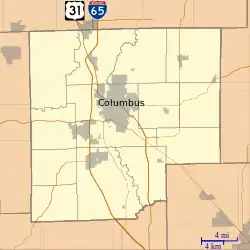Hope Historic District | |
 | |
   | |
| Location | Roughly bounded by Haw Cr., Grand St., Walnut St. and South St., Hope, Indiana |
|---|---|
| Coordinates | 39°18′04″N 85°46′13″W / 39.30111°N 85.77028°W |
| Area | 114 acres (46 ha) |
| Architect | Dunlap, Elmer E.; Weisner, L.W. |
| Architectural style | Greek Revival, Italianate, Hall and parlor |
| NRHP reference No. | 91001864[1] |
| Added to NRHP | December 19, 1991 |
Hope Historic District is a 114-acre (46 ha) national historic district located at Hope, Bartholomew County, Indiana. It encompasses 205 contributing buildings, four contributing sites and two contributing objects in the central business district and surrounding residential areas of Hope. It was developed between about 1840 and 1940, includes works by architect Elmer E. Dunlap and by L.W. Weisner, and notable examples of Greek Revival, Italianate, Hall and parlor, and other architecture. Notable buildings include the Moravian Church (1875) and old parsonage (1875), City School (1906), Baptist Church, Methodist Episcopal Church (1887), Alfred Sanford Rominger House (c. 1840), Frank Stapp House (c. 1890), Masonic Temple (1910), and E.B. Spaugh Building (1915).[2]
It was listed on the National Register of Historic Places in 1991.[1]
References
- 1 2 "National Register Information System". National Register of Historic Places. National Park Service. July 9, 2010.
- ↑ "Indiana State Historic Architectural and Archaeological Research Database (SHAARD)" (Searchable database). Department of Natural Resources, Division of Historic Preservation and Archaeology. Retrieved July 1, 2015. Note: This includes Laura Thayer (November 1990). "National Register of Historic Places Inventory Nomination Form: Hope Historic District" (PDF). Retrieved July 1, 2015. and Accompanying photographs.
External links
 Media related to Hope Historic District (Hope, Indiana) at Wikimedia Commons
Media related to Hope Historic District (Hope, Indiana) at Wikimedia Commons

